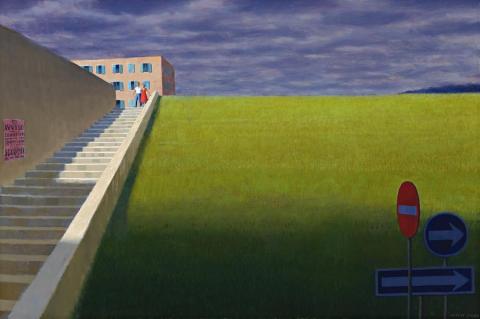VIA LEOPARDI, 2004
JEFFREY SMART
oil on canvas
72.0 x 108.0 cm
signed lower right: JEFFREY SMART
Philip Bacon Galleries, Brisbane (label attached verso)
Private collection, Queensland
Jeffrey Smart, Philip Bacon Galleries, Brisbane, 30 August – 1 October 2005, cat. 8 (illus. in exhibition catalogue)
Returning to Italy after a long trip to Australia in 2003, Jeffrey Smart needed time to recover from a bout of double pneumonia, which saw him hospitalised in Adelaide. Combined with his lifelong asthma condition, the illness weakened his normally robust constitution and he entered a quieter, more constrained period. He returned to painting, working towards an exhibition planned for Philip Bacon Galleries in Brisbane in 2005. Via Leopardi was created for that exhibition and is notable for its lightness of touch and a delicacy in the brushwork " not a lack of confidence, but certainly a more restrained painting. The softer elements of Via Leopardi are countered by the strength and boldness of its composition, proving to all who might be concerned for his health that there was much life and art left in one of Australia's favourite painters.
Via Leopardi is based on the view from the hospital in Montevarchi, near Arezzo, where Smart had gone to recuperate on his return to Italy. Via Leopardi is the main road leading directly to the hospital, at which point it becomes Via Madre Teresa di Calcutta, the romantic poet giving way to the newly beatified. Eager to get back to work, Smart was planning new works even as he lay in his hospital bed.
Geometry and the formal balance of elements are crucial to all the works of Jeffrey Smart, but as he grew older, he became more daring in his compositions and dramatic in the disposition of form and colour. While the formal elements are familiar, Via Leopardi pushes all of Smart's signature devices to their limits. The dramatic low viewpoint and high horizon lift our attention to the couple at the top of the stairs. The long staircase, half in shadow and half in bright sunlight, concentrates the upward view, the strength of the movement countered by the vast expanse of delicately brushed green grass which occupies two thirds of the picture. The arrow of the staircase could easily carry the eye right out of the picture, if not for the strategically placed apartment block (a construct not in the original landscape) and a counter arrangement of three traffic signs in the opposite corner. The signs themselves are pictorial devices colour coded to the view, but the symbols themselves, so clear and seemingly understandable, bring a moment of confusion in their ambiguous instructions. The pink notice, Avviso, on the staircase wall warns of a strike " civil unrest forecast for the peace, stillness and beauty of the grassy knoll. It is classic Jeffrey Smart, moderated and nuanced with the simplicity and restraint of the artist regaining his full powers.
GAVIN FRY
